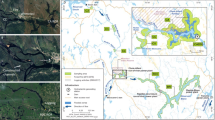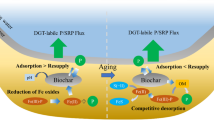Abstract
There is renewed interest in the use of nitrate to treat the profundal zone of lakes to inhibit anaerobic biogeochemical processes that result in the degradation of bottom water quality (e.g., sediment phosphorus release, mercury methylation). In this study we used experimental sediment–water interface chambers to quantify the rate of sediment nitrate uptake (SNU) in profundal sediments from Lake Perris, a eutrophic raw water reservoir in Southern California. Deoxygenated chamber water was spiked with nitrate, and nitrate concentration was monitored over time under quiescent conditions, followed by mixed conditions with average water velocities of 1 cm/s. Key findings included: (1) SNU decreased with decreasing nitrate concentration, (2) SNU was higher under mixed versus quiescent conditions by nearly 50%, and (3) nitrate uptake as a function of nitrate concentration followed a conventional sediment oxygen demand model in which nitrate uptake was proportional to the square root of nitrate concentration. The probable mechanism for elevated SNU under mixed conditions was an increased diffusional concentration gradient combined with a decrease in the diffusional boundary layer at the sediment–water interface, both of which enhanced the flux of nitrate from overlaying water into sediment. Managers planning to implement lake nitrate addition should account for induced nitrate demand when determining dosing rates. For example, based on our modeling efforts from this data set, SNU in Lake Perris could range by an order of magnitude, from around 12 mg N/m2/d under quiescent, low nitrate conditions (0.1 mg N/l) to around 120 mg N/m2/d under mixed, high nitrate conditions (5 mg N/l).



Similar content being viewed by others
References
Arega, F. & J. H. W. Lee, 2005. Diffusional mass transfer at sediment–water interface of cylindrical sediment oxygen demand chamber. Environmental Engineering 131: 755–766.
Ashley, K. A., 1983. Hypolimnetic aeration of a naturally eutrophic lake: physical and chemical effects. Canadian Journal of Fisheries and Aquatic Sciences 40: 1343–1359.
Benoit, J. M., C. C. Gilmour, A. Heyes, R. P. Mason & C. Miller, 2003. Geochemical and biological controls over methylmercury production and degradation in aquatic ecosystems. In Cai, Y. & O. C. Braids (eds), Biochemistry of Environmentally Important Trace Element. American Chemical Society, Washington DC: 262–297.
Benoit, J. M., D. H. Shull, P. Robinson & L. R. Ucran, 2006. Infaunal burrow densities and sediment monomethyl mercury. Marine Chemistry 102: 124–133.
Beutel, M. W., 2003. Hypolimnetic anoxia and sediment oxygen demand in California drinking water reservoirs. Lake and Reservoir Management 19: 208–221.
Beutel, M. W., 2006. Inhibition of ammonia release from anoxic profundal sediments in lakes using hypolimnetic oxygenation. Ecological Engineering 28: 271–279.
Beutel, M. W. & A. J. Horne, 1999. A review of the effects of hypolimnetic oxygenation on lake and reservoir water quality. Lake and Reservoir Management 15: 285–297.
Beutel, M. W., A. J. Horne, J. C. Roth & N. J. Barratt, 2001. Limnological effects of anthropogenic desiccation in a large, saline lake, Walker Lake, Nevada. Hydrobiologia 446: 91–105.
Beutel, M. W., N. Burley & K. Culmer, 2006. Quantifying the effects of water velocity and oxygen concentration on sediment oxygen demand. Hydrological sciences and technology. Journal of the American Institute of Hydrology 22: 15–28.
Beutel, M. W., T. M. Leonard, S. R. Dent & B. C. Moore, 2007a. Effects of aerobic and anaerobic conditions on P, N, Fe, Mn and Hg accumulation in waters overlaying profundal sediments of an oligo-mesotrophic lake. Water Research 42: 1953–1962.
Beutel, M. W., I. Hannoun, J. Pasek & K. Bowman Kavanagh, 2007b. Hypolimnetic oxygenation pre-design study for a large eutrophic raw water reservoir, San Vicente Reservoir, CA. Environmental Engineering 133: 130–138.
Boström, B., J. A. Andersen, S. Fleischer & M. Jansson, 1988. Exchange of phosphorus across the sediment–water interface. Hydrobiologia 179: 229–244.
Bouldin, D. R., 1968. Models for describing the diffusion of oxygen and other mobile constituents across the mud–water interface. Journal of Ecology 56: 77–87.
Chapra, S. C., 1997. Surface Water-Quality Modeling. WCB/McGraw-Hill, Boston.
Cooke, G. D., R. T. Heath, R. H. Kennedy & M. R. McComas, 1982. Change in lake trophic status and internal phosphorus release after aluminum sulfate application. Water Resources Bulletin 18: 699–705.
Cooke, G. D., E. B. Welch, S. A. Peterson & S. A. Nichols, 2005. Restoration and Management of Lakes and Reservoirs, 3rd ed. CRC Press, Boca Raton, FL.
Characklis, W. G. & K. C. Marshall, 1990. Biofilms. Wiley, New York.
Daigle, D., 2003. Dead seas: nutrient pollution in coastal waters. Multinational Monitor 24: 12.
Dinsmore, W. P. & E. E. Prepas, 1997. Impact of hypolimnetic oxygenation on profundal macroinvertebrates in a eutrophic lake in central Alberta. I. Changes in macroinvertebrate abundance and diversity. Canadian Journal of Fishery and Aquatic Sciences 54: 2157–2169.
Di Toro, D. M., P. R. Paquin, K. Subburamu & D. A. Gruber, 1990. Sediment oxygen demand model: methane and ammonia oxidation. Environmental Engineering 116: 945–986.
Eckley, C. S. & H. Hintelmann, 2006. Determination of mercury methylation potential in the water column of lakes across Canada. Science of the Total Environment 368: 111–125.
Effler, S. W. & D. A. Matthews, 2008. Implications of redox processes for the rehabilitation of an urban lake, Onondaga Lake, NY. Lake and Reservoir Management (in press).
Elser, J. J., M. E. S. Bracken, E. E. Cleland, D. S. Gruner, W. S. Harpole, H. Hillebrand, J. T. Ngai, E. W. Seabloom, J. B. Shurin & J. E. Smith, 2007. Global analysis of nitrogen and phosphorus limitation of primary producers in freshwater, marine and terrestrial ecosystems. Ecology Letters 10: 1135–1142.
Foy, R. H., 1986. Suppressions of phosphorus release from lake sediments by the addition of nitrate. Water Research 20: 1345–1351.
Golterman, H. L., 2001. Phosphate release from anoxic sediments or ‘What did Mortimer really write?’. Hydrobiologia 450: 99–106.
Höhener, P. & R. Gächter, 1993. Prediction of dissolved inorganic nitrogen (DIN) concentrations in deep, seasonally stratified lakes based on rates of DIN input and N removal processes. Aquatic Sciences 55: 112–131.
Jones, J. G., 1985. Denitrification in freshwaters. In Golterman, H. L. (ed.), Denitrification in the Nitrogen Cycle. Plenum Press, New York: 225–239.
Lebo, M. E., J. E. Reuter & C. R. Goldman, 1994. Pyramid Lake, Nevada, Water Quality Study 1989–1993. University of California, Davis.
Lindberg, S., R. Bullock, R. Ebinghaus, D. Engstrom, X. Feng, W. Fitzgerald, N. Pirrone, E. Prestbo & C. Seigneur, 2007. The Madison declaration on mercury pollution. Ambio 36: 62–65.
Lorenzen, J., L. H. Larsen, T. Kjaer & N. P. Revsbech, 1998. Biosensor determination of the microscale distribution of nitrate, nitrate assimilation, nitrification, and denitrification in a diatom-inhabited freshwater sediment. Applied and Environmental Microbiology 64: 3264–3269.
McQueen, D. J. & D. R. S. Lean, 1986. Hypolimnetic aeration: An overview. Water Pollution Journal of Canada 21: 205–217.
Mengis, M., R. Gächter & B. Wehrli, 1997. Nitrogen elimination in two deep eutrophic lakes. Limnology and Oceanography 42: 1530–1543.
Moore, B. C., P. H. Chen, W. H. Funk & D. Yonge, 1996. A model for predicting lake sediment oxygen demand following hypolimnetic aeration. Water Resources Bulletin 32: 1–9.
Nakamura, Y. & H. G. Stefan, 1994. Effects of flow velocity on sediment oxygen demand: theory. Environmental Engineering 120: 996–1016.
Nürnberg, G. K., 1988. Prediction of phosphorus release rates from total and reductant-soluble phosphorus in anoxic lake sediments. Canadian Journal of Fisheries and Aquatic Sciences 45: 453–462.
Prepas, E. E., K. M. Field, T. P. Murphy, W. L. Johnson, J. M. Burke & W. M. Tonn, 1997. Introduction to the Amisk Lake Project: oxygenation of a deep, eutrophic lake. Canadian Journal of Fisheries and Aquatic Sciences 54: 2105–2110.
Reynoldson, T. B., 1987. The role of environmental factors in the ecology of tubificid oligochaetes–an experimental study. Holarctic Ecology 10: 241–248.
Ripl, W., 1976. Biochemical oxidation of polluted lake sediment with nitrate––a new restoration method. Ambio 5: 132.
Risgaard-Petersen, N., S. Skårup & L. P. Nielsen, 1999. Denitrification in a soft bottom lake: evaluation of laboratory incubations. Aquatic Microbial Ecology 17: 279–287.
Rysgaard, S., N. Risgaard-Petersen, N. P. Sloth, K. Jensen & L. P. Nielsen, 1994. Oxygen regulation of nitrification and denitrification in sediments. Limnology and Oceanography 39: 1643–1652.
Saether, O. A., 1979. Chironomid communities as water quality indicators. Holarctic Ecology 2: 65–74.
Seitzinger, S. P., 1988. Denitrification in freshwater and coastal marine ecosystems: ecological and geochemical significance. Limnology and Oceanography 33: 702–724.
Slotton, D. G., J. E. Reuter & C. R. Goldman, 1995. Mercury uptake patterns of biota in a seasonally anoxic northern California reservoir. Water Air and Soil Pollution 80: 841–850.
Søndergaard, M., E. Jeppesen & J. P. Jensen, 2000. Hypolimnetic nitrate treatment to reduce internal phosphorus loading in a stratified lake. Lake and Reservoir Management 16: 195–204.
Søndergaard, M., J. P. Jensen & E. Jeppesen, 2003. Role of sediment and internal loading of phosphorus in shallow lakes. Hydrobiologia 506–509: 135–145.
Svensson, J. M., 1997. Influence of Chironomus plumosus larvae on ammonium flux and denitrification (measured by the acetylene blockage- and the isotope pairing-technique) in eutrophic lake sediment. Hydrobiologia 346: 157–168.
Vincent, W. F. & M. T. Downes, 1981. Nitrate accumulation in aerobic hypolimnia: relative importance of benthic and planktonic nitrifiers in an oligotrophic lake. Applied and Environmental Microbiology 42: 565–573.
Walker, R. R. & W. J. Snodgrass, 1986. Model for sediment oxygen demand in lakes. Environmental Engineering 112: 25–43.
Welch, E. B. & G. D. Cooke, 1995. Internal phosphorus loading in shallow lakes: importance and control. Lake and Reservoir Management 11: 273–281.
Welch, E. B. & G. D. Cooke, 1998. Effectiveness and longevity of phosphorus inactivation with alum. Lake and Reservoir Management 15: 5–27.
Welch, E. B. & J. M. Jacoby, 2001. On determining the principle source of phosphorus causing summer algal blooms in western Washington lakes. Lake and Reservoir Management 17: 55–65.
Zar, J. H., 1984. Biostatistical Methods, 2nd ed. Prentice-Hall, New Jersey.
Acknowledgments
We would like to thank Dr. William Taylor and his staff at the Metropolitan Water District of Southern California for their field support during this project, and our undergraduate assistant Kayla Culmer. We would also like to thank Dr. Alex Horne (University of California, Berkeley), Dr. Martin Søndergaard (National Environmental Research Institute, Denmark), and the anonymous reviewers for their constructive comments on the manuscript.
Author information
Authors and Affiliations
Corresponding author
Additional information
Handling editor: L. Naselli-Flores
Rights and permissions
About this article
Cite this article
Beutel, M.W., Burley, N.R. & Dent, S.R. Nitrate uptake rate in anoxic profundal sediments from a eutrophic reservoir. Hydrobiologia 610, 297–306 (2008). https://doi.org/10.1007/s10750-008-9445-6
Received:
Revised:
Accepted:
Published:
Issue Date:
DOI: https://doi.org/10.1007/s10750-008-9445-6




